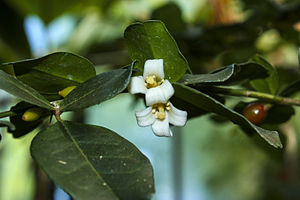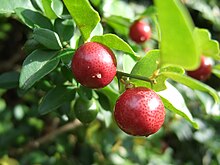Lemonberry
This article was based on formal or substantive deficiencies in the quality assurance biology in the section "plants" entered for improvement. This is done in order to bring the quality of the biology articles to an acceptable level. Please help improve this article! Articles that are not significantly improved can be deleted if necessary.
Read the more detailed information in the minimum requirements for biology articles .
Reason: no documents + incomplete
| Lemonberry | ||||||||||||
|---|---|---|---|---|---|---|---|---|---|---|---|---|

Lemonberry ( Triphasia trifolia ), |
||||||||||||
| Systematics | ||||||||||||
|
||||||||||||
| Scientific name | ||||||||||||
| Triphasia trifolia | ||||||||||||
| ( Burm. F. ) P. Wilson |
The lemonberry ( Triphasia trifolia (Burm. F.) P.Wilson , Syn .: Limonia trifolia Burm. F. , Triphasia aurantiola Lour. ), Also called lime berry, limeberry, orangeberry, is a species of the genus Triphasia within the rhombus family (Rutaceae). Their natural range is in tropical Southeast Asia , for example in Malaysia or the Philippines .
description
Vegetative characteristics
Triphasia trifolia is a thorny, evergreen shrub and reaches heights of 3 meters or a little more.
The short-stalked leaves are threefold, and each dark green, glossy, short-stalked, entire-margined to finely notched, leathery, stiff leaf is 2 to 5 inches long and 1 to 3.5 inches wide. The foremost leaflet is considerably larger than the two on the side. The egg-shaped to rounded, almost glabrous, underneath light to pale green leaflets are blunt to truncated or rounded and often indented, more rarely pointed. The veins are pinnate, with a central vein slightly embossed on top and indistinct side veins. There may be one or two stipule thorns at a time .
Generative characteristics
There are axillary or terminal, short and racemose , little-flowered inflorescences or the flowers appear individually. The hermaphroditic, small flowers are threefold with a double flower envelope , 1 to 2 centimeters in size and exude an intense, spicy, floral smell. The tricuspid chalice is small. There are three white, bell-shaped fused petals with recessed lobes and two circles with three stamens each. The bald, oblong ovary with short, thick pen with fleshy, capitate and lobed stigma is upper constant. There is a discus .
The round to egg-shaped, small and smooth, to three-seeded fruits are edible, finely dotted berries , 1 to 1.5 centimeters in size and become intensely red when ripe. The taste of the " fruit pulp " is reminiscent of a sweet and tart lime , with the firm skin tasting significantly more bitter than the juicy "pulp".
Chromosome number
The number of chromosomes is 2n = 18.
Occurrence
The natural range of Triphasia trifolia is in tropical Southeast Asia , for example in Malaysia or the Philippines . The species is cultivated in many countries and is also often a neophyte.
use
In many subtropical and tropical regions, the lemonberry is grown for its edible fruit and in some tropical areas it could even be a potential, promising crop . In many regions, Triphasia trifolia is considered an invasive plant .
Web links
- Triphasia trifolia at NYBG (pictures at Scientific Name).
- Triphasia trifolia at Useful Tropical Plants.
- Triphasia trifolia at UCR: Citrus Variety Collection.
Individual evidence
- ↑ Triphasia trifolia at Tropicos.org. In: IPCN Chromosome Reports . Missouri Botanical Garden, St. Louis
- ↑ Triphasia in the Germplasm Resources Information Network (GRIN), USDA , ARS , National Genetic Resources Program. National Germplasm Resources Laboratory, Beltsville, Maryland. Retrieved June 10, 2017.
- ↑ Triphasia trifolia at Plants For A Future . Retrieved June 10, 2015.
- ↑ Data sheet at Invasive Species Compendium by CABI.


